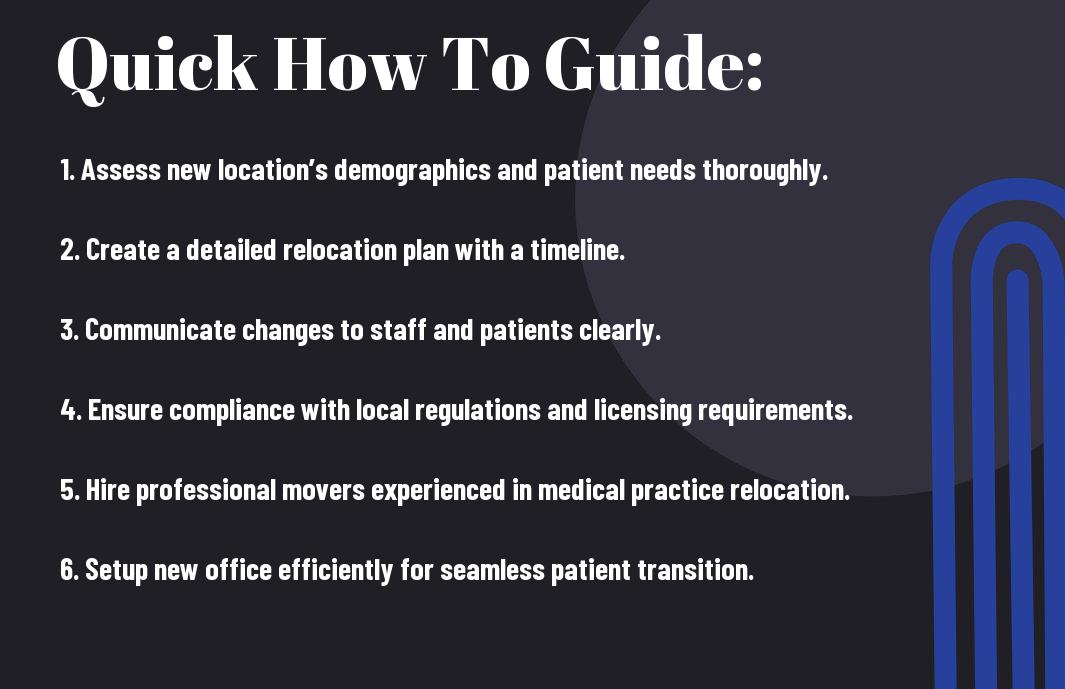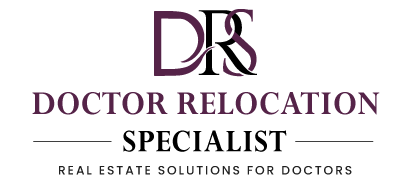Over the course of your medical career, relocating your practice can bring about a range of challenges that may feel daunting. From managing patient communication to ensuring compliance with local regulations, these obstacles can disrupt your workflow and negatively impact your staff and patients. In this post, you’ll discover the top seven challenges you might face during a medical practice relocation, along with effective strategies to overcome them, ensuring a smooth transition for you and your practice.

How to Assess the Right Location for Your Practice
For a successful medical practice relocation, assessing the right location is crucial. Consider your target patient demographic, the accessibility of the site, and the overall growth potential of the area. These factors will significantly influence your practice’s visibility and patient engagement.
Key Factors to Consider
You should evaluate several key elements before deciding on a location:
- Proximity to hospitals and other medical facilities
- Access to major transportation routes
- Foot traffic and visibility
- Local population growth trends
- Availability of parking
Recognizing these factors can lead you to a location that fosters a thriving practice.
Tips for Analyzing Demographics and Competition
Competition in your chosen area will significantly affect your practice’s success. Analyzing local demographics and the competitive landscape involves:
- Studying the age and income levels of the population
- Identifying existing healthcare providers in the vicinity
- Evaluating the specialties offered by competitors
- Assessing the demand for specific healthcare services
The data gathered will guide you in tailoring your services and marketing strategies effectively.
Another approach to analyzing demographics and competition is to use various data sources and tools. Consider:
- Utilizing census data for population insights
- Exploring online platforms for competitor reviews
- Engaging with community surveys to understand patient needs
- Consulting local business directories for healthcare provider information
The insights gained will empower you to make informed decisions regarding your practice’s offerings and positioning in the market.
How to Plan the Relocation Logistics
You need to develop a comprehensive plan that outlines every aspect of your medical practice relocation. From timeline management and budgeting to communication strategies with patients and staff, every detail matters. Start by creating a check-list to keep track of tasks, set deadlines, and ensure a seamless transition to your new location. Involve your team early on to foster collaboration, and designate responsibilities to streamline the moving process. Understanding the sequence of events will keep you organized and minimize disruptions in service during the move.
Steps for Organizing the Move
You should begin by assessing your current situation, compiling a list of all items that will be moved, and determining what needs to be updated or replaced. Next, establish a detailed timeline that outlines when each step should be completed, keeping in mind any lease or service contract requirements. Seek professional movers with experience in medical practice relocations, and communicate a clear plan with your staff to ensure everyone understands their roles during the transition.
Important Considerations for Equipment and Staff
Relocation requires careful coordination of both your medical equipment and team members to ensure minimal disruption. You’ll want to evaluate all machinery and technology for their transportability and functionality in the new space. Involve your IT department to manage data migration and any necessary system updates. Additionally, ensure that staff are adequately prepared for the transition by scheduling training sessions for new equipment or procedures in the new location.
Important considerations also include ensuring that staff are informed about changes in work schedules, patient rosters, and new location details. Maintain open lines of communication to address any concerns they may have and to keep morale high throughout the process. Furthermore, consider how the new layout and environment will accommodate both your team and your patients, ensuring a smooth operation once you settle into the new practice location.

How to Communicate with Patients About the Move
Once again, open and transparent communication is key when relocating your medical practice. Informing your patients about the move is not only imperative for logistics but also for maintaining their trust and loyalty. You should proactively share details about the change, including the new location, any changes in services, and the timeline for the transition. By keeping patients informed, you foster a sense of security during a potentially disruptive time.
Effective Communication Strategies
Patients will appreciate your clarity when you implement structured communication methods. Keep them updated through various channels, like email newsletters, text messages, or your practice’s website. Consider hosting an informational session or Q&A to address their concerns and ensure they have all relevant information. The emphasis should be on maintaining an ongoing dialogue to create a comforting environment during the transition.
Tips for Maintaining Patient Trust
With your relocation, it’s important to ensure that your patients feel secure in their care. You can employ several strategies to uphold their trust as you move:
- Be honest and transparent about the reasons for the move.
- Highlight the benefits of the new location, like improved services or accessibility.
- Provide adequate notice and multiple reminders to keep patients informed.
- Offer personalized communication, such as phone calls or letters, for your long-term patients.
This proactive approach will give your patients confidence in your commitment to their well-being.
With enhanced communication plans, you can further strengthen patient trust. Consider the following strategies:
- Host a “meet-and-greet” in the new location before the official move.
- Keep your current staff informed so they can answer patient inquiries consistently.
- Share success stories or testimonials related to the move to build optimism.
- Provide details on how you will maintain quality care during the transition.
This will help your patients feel valued and reassure them that their care remains your top priority.
How to Manage Financial Implications
Despite the numerous advantages of relocating your medical practice, the financial implications can be daunting. It’s important to manage your finances effectively to ensure a smooth transition. This involves careful planning and an understanding of both fixed and variable costs associated with the move, helping you avoid unexpected expenses that could disrupt your practice’s stability.
Budgeting for the Relocation
Budgeting is the foundation of managing your relocation expenses. Start by detailing all anticipated costs, including new lease agreements, renovations, equipment relocation, and hiring professional moving services. Allocate a buffer for unforeseen expenses to maintain financial flexibility during the process, allowing you to focus on patient care without financial stress.
Exploring Funding Options
On your journey to relocate, exploring funding options can provide financial relief and support. Various sources, such as bank loans, grants, or even partnerships, can lessen the financial burden that comes with relocating your medical practice.
Another approach to funding your relocation is to investigate grants available specifically for health care providers, which may offer financial assistance tailored to your needs. Additionally, consider establishing partnerships with local businesses or exploring community sponsorships that can enhance your financial resources. Taking the time to research these avenues can pave the way for a smoother financial transition, allowing you to focus on rebuilding and enhancing your practice in the new location.
How to Ensure Compliance with Regulations
After relocating your medical practice, ensuring compliance with local, state, and federal regulations is vital for operational success. You need to familiarize yourself with pertinent legal requirements, including patient privacy laws, licensing, and facility standards. A misstep in compliance can lead to significant obstacles, so it’s imperative to be proactive and thorough in understanding these regulations.
Key Regulations to Consider
The landscape of medical regulations can be complex, encompassing various aspects such as HIPAA, OSHA guidelines, and state-specific licensing requirements. You should also consider zoning laws and any requirements pertinent to your specific medical specialty. Thoroughly understanding these regulations is key to a smooth transition and maintaining the integrity of your practice.
Tips for Staying Informed and Compliant
Ensure you stay updated on regulatory changes by actively engaging with professional organizations and utilizing reliable resources. Attend workshops, reach out to regulatory bodies, and network with peers in your field. Here are some helpful strategies to maintain compliance:
- Subscribe to industry newsletters for the latest updates.
- Complete continuing education courses related to compliance.
- Designate a compliance officer within your practice.
Perceiving the importance of staying informed will help you mitigate potential risks associated with regulatory noncompliance.
Informed practices prioritize ongoing education and proactive engagement with the regulatory landscape. You can set up regular meetings with your compliance officer to review updates and discuss potential changes. Furthermore, engage with online forums or community networks to share insights regarding best practices. Here’s how to enhance your information-gathering efforts:
- Follow relevant regulatory agencies on social media for immediate updates.
- Participate in local medical associations and committees.
- Utilize compliance management tools to track changes.
Perceiving these strategies as integral to your practice will empower you to navigate regulatory complexities effectively.
How to Optimize the New Practice Space
Unlike your previous location, optimizing the new practice space requires thoughtful planning and execution. This includes assessing the layout, ensuring efficient use of resources, and fostering a welcoming atmosphere for both staff and patients. By focusing on these elements, you can create a space that promotes productivity, comfort, and a positive experience for everyone who enters your practice.
Designing for Efficiency and Comfort
You should prioritize both efficiency and comfort when designing your new practice space. This involves creating a layout that minimizes unnecessary movement for staff and ensures that patients can navigate effortlessly. Consider incorporating ergonomic furniture and easy access to necessary equipment to enhance productivity and comfort throughout the practice.
Tips for Creating a Patient-Friendly Environment
To create a patient-friendly environment, focus on elements that enhance comfort and engagement. Consider the following strategies:
- Provide ample seating in waiting areas.
- Use calming colors and natural light.
- Offer informative materials about services.
- Incorporate art or plants to soften the space.
Any changes you implement can significantly reduce patient anxiety and create a welcoming atmosphere.
Environment plays a vital role in patient satisfaction and overall experience in your medical practice. By enhancing your space thoughtfully, you can improve not only aesthetics but also function. Here are additional recommendations:
- Maintain cleanliness and organization throughout.
- Ensure clear signage for ease of navigation.
- Consider privacy in waiting areas and consultation rooms.
- Encourage staff to engage positively with patients.
Any environment that prioritizes comfort and accessibility will likely lead to better outcomes and stronger patient relationships.
Summing up
Upon reflecting on the top 7 challenges in medical practice relocation, it’s clear that forward planning and thorough understanding of your specific needs can significantly ease the transition. By addressing issues such as patient retention, regulatory compliance, and financial considerations proactively, you can ensure a smoother move. Engaging with professionals in legal, financial, and logistical aspects will also provide valuable insights. Ultimately, your successful relocation depends on a detailed strategy and a commitment to maintaining quality care throughout the process.

